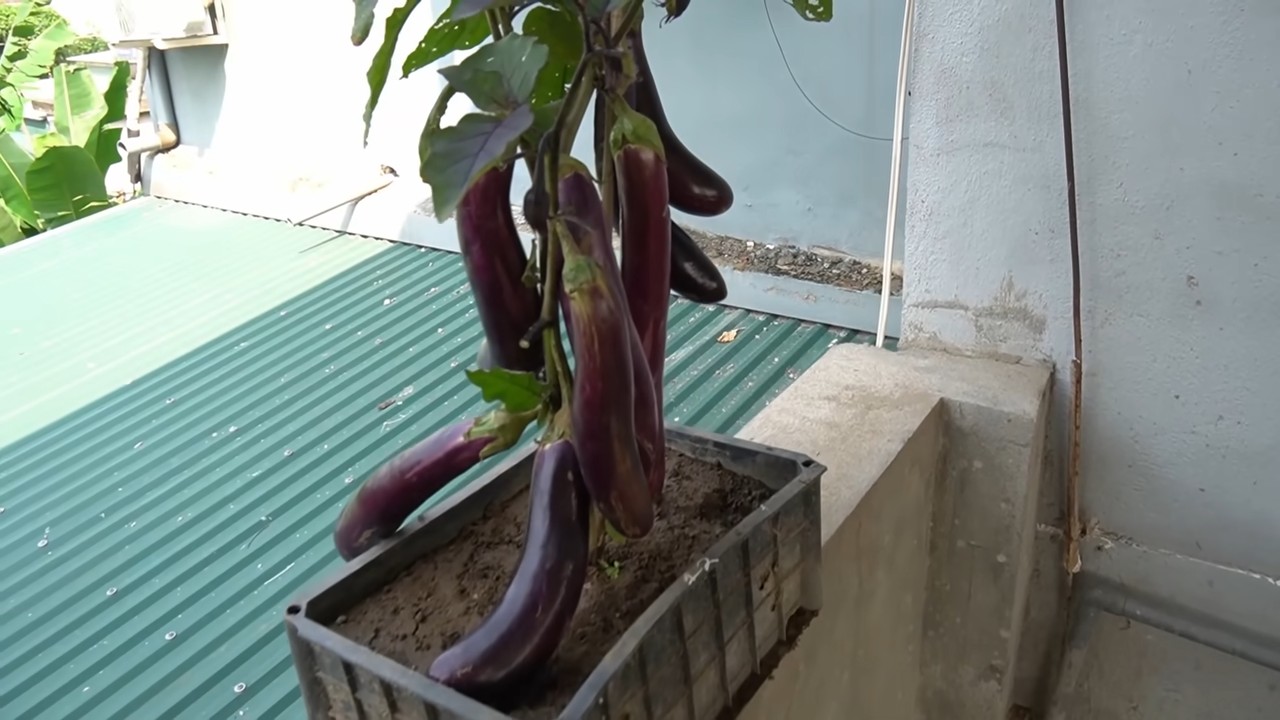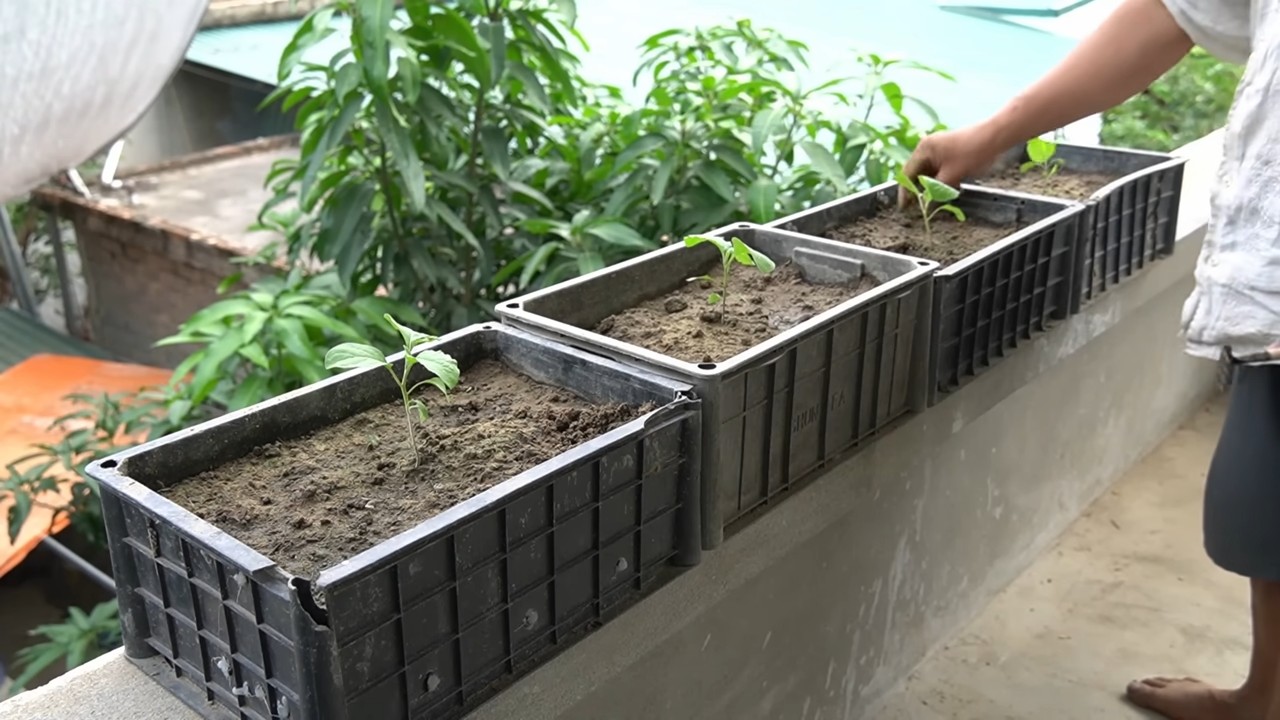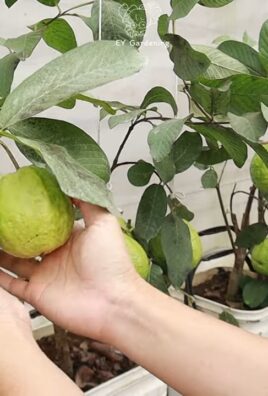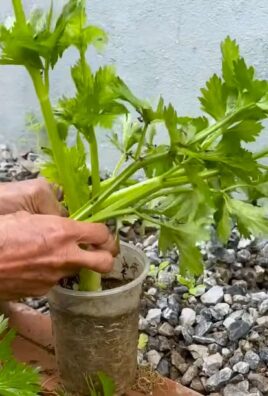Bucket gardening eggplants – sounds intriguing, right? I’m so excited to share some simple yet effective DIY tricks that will have you harvesting beautiful, plump eggplants even if you’re short on space! Forget sprawling gardens; we’re going vertical (or rather, containerized!) and bringing the farm-to-table experience right to your balcony, patio, or even a sunny windowsill.
Eggplants, with their glossy purple skin, have a rich history, originating in India and making their way across the globe. They’ve been a staple in cuisines from the Mediterranean to Asia for centuries. But let’s be honest, growing them can sometimes feel like a challenge. That’s where these DIY hacks come in!
In today’s busy world, who has time for endless weeding and complicated gardening techniques? That’s why I’m passionate about making gardening accessible to everyone. Bucket gardening eggplants is the perfect solution for urban dwellers, apartment residents, or anyone who wants to enjoy fresh, homegrown produce without the hassle of a traditional garden. These tips will help you overcome common eggplant-growing hurdles, like pest control and proper watering, ensuring a bountiful harvest. So, grab your buckets, some soil, and let’s get growing!

DIY Bucket Gardening: Grow Your Own Delicious Eggplants!
Hey there, fellow gardening enthusiasts! I’m so excited to share my tried-and-true method for growing plump, juicy eggplants right in buckets. It’s easier than you think, even if you don’t have a sprawling backyard. Bucket gardening is perfect for patios, balconies, or any small space. Let’s get started!
What You’ll Need
Before we dive in, let’s gather our supplies. This is crucial for a smooth and successful eggplant-growing adventure.
* Buckets: 5-gallon buckets are ideal. You can use plastic or even repurposed metal buckets, but make sure they’re clean and food-grade if possible.
* Eggplant Seedlings: You can start your own from seeds (which takes a bit longer) or buy healthy seedlings from a local nursery. I usually opt for seedlings to save time.
* Potting Mix: Don’t skimp on this! Use a high-quality potting mix specifically formulated for vegetables. Avoid garden soil, as it can compact in containers.
* Fertilizer: A slow-release granular fertilizer and a liquid fertilizer are your best friends. I prefer a balanced formula (like 10-10-10) for the granular and a bloom-boosting liquid fertilizer later on.
* Watering Can or Hose: Essential for keeping your eggplants hydrated.
* Trowel or Small Shovel: For transplanting the seedlings.
* Gloves: Protect your hands from dirt and potential irritants.
* Optional: Stakes or cages for support (eggplants can get heavy!).
* Optional: Mulch (like straw or wood chips) to help retain moisture.
Preparing Your Buckets
This step is all about setting the stage for happy, healthy eggplants. Proper drainage is key to preventing root rot.
1. Drill Drainage Holes: This is super important! Drill at least 4-5 drainage holes in the bottom of each bucket. I usually use a 1/2-inch drill bit.
2. Add a Layer of Gravel (Optional): Some gardeners like to add a layer of gravel or small rocks to the bottom of the bucket to further improve drainage. I sometimes do this, but it’s not absolutely necessary if you have good drainage holes.
3. Fill with Potting Mix: Now, fill your buckets with the high-quality potting mix, leaving about 2-3 inches of space at the top. This space will make watering easier and prevent soil from splashing out.
Planting Your Eggplant Seedlings
Time to get those little guys into their new homes! Handle the seedlings gently to avoid damaging their delicate roots.
1. Dig a Hole: In the center of each bucket, dig a hole that’s large enough to accommodate the root ball of your eggplant seedling.
2. Gently Remove the Seedling: Carefully remove the seedling from its container. If the roots are tightly bound, gently loosen them with your fingers.
3. Place the Seedling: Place the seedling in the hole, making sure the top of the root ball is level with the surrounding soil.
4. Fill and Pat Down: Fill the hole with potting mix and gently pat it down around the base of the plant.
5. Water Thoroughly: Water the newly planted seedling thoroughly until water drains out of the drainage holes. This helps settle the soil and encourages root growth.
Caring for Your Eggplants
This is where the real work begins, but it’s also the most rewarding part! Consistent care is essential for a bountiful harvest.
1. Sunlight: Eggplants need at least 6-8 hours of direct sunlight per day. Choose a sunny spot for your buckets. If you live in a particularly hot climate, some afternoon shade can be beneficial.
2. Watering: Water your eggplants regularly, especially during hot, dry weather. Check the soil moisture by sticking your finger about an inch into the soil. If it feels dry, it’s time to water. Avoid overwatering, as this can lead to root rot. I usually water deeply every 2-3 days, but this will depend on your climate and the size of your plants.
3. Fertilizing:
* Initial Feeding: After planting, sprinkle a slow-release granular fertilizer around the base of each plant, following the instructions on the package.
* Regular Feeding: Begin feeding with a liquid fertilizer every 2-3 weeks, starting about a month after planting. I like to use a bloom-boosting fertilizer once the plants start to flower.
4. Support: As your eggplants grow, they may need support to prevent the branches from breaking under the weight of the fruit. You can use stakes or cages to provide support. I find that cages work best for me, as they provide all-around support.
5. Pruning: Pruning can help improve air circulation and encourage fruit production. Remove any yellowing or dead leaves. You can also pinch off suckers (small shoots that grow from the base of the plant) to encourage the plant to focus its energy on fruit production.
6. Pest Control: Keep an eye out for pests like aphids, flea beetles, and spider mites. If you spot any pests, you can try spraying them with insecticidal soap or neem oil. I prefer to use organic pest control methods whenever possible.
7. Pollination: Eggplants are self-pollinating, but sometimes they need a little help. You can gently shake the plants or use a small paintbrush to transfer pollen from one flower to another. This is especially important if you’re growing your eggplants indoors or in a sheltered area where there aren’t many pollinators.
Harvesting Your Eggplants
The moment you’ve been waiting for! Knowing when to harvest is key to enjoying the best flavor and texture.
1. Check for Size and Color: Eggplants are typically ready to harvest when they’re about two-thirds of their mature size and have a glossy, vibrant color. The skin should be firm and slightly resistant to pressure.
2. Test for Ripeness: Gently press the skin of the eggplant. If it springs back quickly, it’s ripe. If it leaves a dent, it’s overripe.
3. Cut, Don’t Pull: Use a sharp knife or pruning shears to cut the eggplant from the plant, leaving about an inch of stem attached.
4. Harvest Regularly: Harvest your eggplants regularly to encourage the plant to produce more fruit.
Troubleshooting
Even with the best care, you might encounter some challenges. Here are a few common problems and how to address them:
* Yellowing Leaves: This could be a sign of overwatering, underwatering, nutrient deficiency, or pest infestation. Check the soil moisture, fertilize if necessary, and inspect the plant for pests.
* Blossom End Rot: This is caused by a calcium deficiency and results in a dark, sunken spot on the bottom of the fruit. Ensure consistent watering and consider adding calcium to the soil.
* Lack of Fruit: This could be due to insufficient sunlight, poor pollination, or nutrient deficiency. Make sure your plants are getting enough sunlight, hand-pollinate if necessary, and fertilize regularly.
* Pest Infestations: Regularly inspect your plants for pests and take action promptly if you spot any. Insecticidal soap, neem oil, and hand-picking are all effective methods for controlling pests.
Choosing the Right Eggplant Variety
The type of eggplant you choose can significantly impact your success, especially in a bucket garden. Here are a few varieties that I’ve found thrive in containers:
* ‘Patio Baby’: As the name suggests, this variety is perfect for containers. It produces small, bite-sized eggplants that are ready to harvest in about 50 days.
* ‘Fairy Tale’: This variety produces beautiful, striped eggplants that are both ornamental and delicious. It’s also relatively compact, making it a good choice for buckets.
* ‘Little Fingers’: This variety produces long, slender eggplants that are tender and flavorful. It’s a prolific producer and does well in containers.
* ‘Black Beauty’: This is a classic eggplant variety that produces large, dark purple fruits. While it can be grown in buckets, it may require more support than other varieties.
Tips for Success
Here are a few extra tips to help you grow the best eggplants possible:
* Rotate Your Crops: If you’re growing eggplants in the same buckets year after year, rotate your crops to prevent soilborne diseases.
* Use Companion Plants: Plant basil, marigolds, or other companion plants near your eggplants to deter pests and attract beneficial insects.
* Mulch Around Your Plants: Mulch helps retain moisture, suppress weeds, and regulate soil temperature.
* Don’t Be Afraid to Experiment:

Conclusion
So, there you have it! Transforming a simple bucket into a thriving eggplant haven is not only achievable but surprisingly rewarding. We’ve walked through the steps, highlighted the benefits, and hopefully, inspired you to embrace this fantastic DIY gardening method. Why is bucket gardening eggplants a must-try? Because it offers a potent blend of convenience, control, and cost-effectiveness, all while yielding delicious, homegrown eggplants.
Think about it: no more back-breaking tilling, battling unpredictable soil conditions, or worrying about space constraints. Bucket gardening puts you in the driver’s seat, allowing you to tailor the environment to your eggplant’s precise needs. You can easily move your buckets to chase the sun, protect them from unexpected frosts, or simply rearrange your garden layout as you please. Plus, the focused environment often leads to healthier plants and a more bountiful harvest.
But the beauty of bucket gardening lies in its adaptability. Feel free to experiment with different eggplant varieties. From the classic Black Beauty to the slender Japanese types or even the vibrant Thai green eggplants, the possibilities are endless. Consider companion planting within your bucket. Marigolds can deter pests, while basil can enhance the flavor of your eggplants. Don’t be afraid to get creative with your container decorations, either. A splash of paint or some decorative stones can transform a simple bucket into a charming garden feature.
And speaking of variations, consider the type of potting mix you use. While a general-purpose mix works well, you can enhance drainage and nutrient retention by adding perlite, vermiculite, or compost. For an extra boost, incorporate slow-release fertilizer granules into the soil at planting time. Remember to monitor your plants regularly for signs of pests or diseases and take prompt action to address any issues.
Ultimately, bucket gardening eggplants is more than just a gardening technique; it’s an invitation to connect with nature, nurture your own food, and experience the satisfaction of harvesting your own delicious eggplants. It’s a project that’s perfect for beginners and seasoned gardeners alike, and it’s a fantastic way to bring the joy of gardening to even the smallest of spaces.
We wholeheartedly encourage you to give this DIY trick a try. Gather your buckets, select your eggplant seedlings, and get ready to embark on a rewarding gardening adventure. And most importantly, we want to hear about your experience! Share your photos, tips, and triumphs with us in the comments below. Let’s create a community of bucket gardening enthusiasts and inspire others to discover the joys of growing their own food. Happy gardening!
Frequently Asked Questions (FAQ)
What size bucket is best for growing eggplants?
The ideal bucket size for growing eggplants is at least 5 gallons, but 10 gallons is even better. Larger buckets provide more room for the roots to grow and allow for better water retention, which is crucial for healthy eggplant development. A 5-gallon bucket can work for smaller varieties, but for larger, more productive plants, opt for a 10-gallon or even larger container. Ensure the bucket has drainage holes to prevent waterlogging.
What type of soil should I use for bucket gardening eggplants?
A well-draining potting mix is essential for successful bucket gardening. Avoid using garden soil, as it tends to compact in containers and can hinder root growth. A good potting mix will consist of a blend of peat moss, perlite, and vermiculite. You can also amend the mix with compost or aged manure to provide additional nutrients. Look for a potting mix specifically formulated for vegetables or create your own blend.
How often should I water my eggplant plants in buckets?
Watering frequency depends on several factors, including the weather, the size of the bucket, and the stage of plant growth. Generally, you should water your eggplant plants when the top inch of soil feels dry to the touch. During hot, dry weather, you may need to water daily or even twice a day. Avoid overwatering, as this can lead to root rot. Check the drainage holes to ensure water is draining properly. A good rule of thumb is to water deeply until water drains out of the bottom of the bucket.
How much sunlight do eggplants need when grown in buckets?
Eggplants are sun-loving plants and require at least 6-8 hours of direct sunlight per day to thrive. Choose a location for your buckets that receives ample sunlight throughout the day. If you live in a particularly hot climate, you may need to provide some afternoon shade to prevent the plants from overheating. If you don’t have a sunny spot, consider using grow lights to supplement the natural sunlight.
Do I need to fertilize my eggplant plants in buckets?
Yes, fertilizing is crucial for healthy eggplant growth and fruit production. Eggplants are heavy feeders and require regular fertilization to provide them with the nutrients they need. Use a balanced fertilizer (e.g., 10-10-10) or a fertilizer specifically formulated for vegetables. Follow the instructions on the fertilizer package for application rates. You can also use organic fertilizers, such as compost tea or fish emulsion. Fertilize every 2-3 weeks during the growing season.
How do I prevent pests and diseases from affecting my eggplant plants in buckets?
Regularly inspect your plants for signs of pests or diseases. Common pests that affect eggplants include aphids, flea beetles, and spider mites. You can control these pests with insecticidal soap, neem oil, or by handpicking them off the plants. Diseases that can affect eggplants include fungal diseases like early blight and verticillium wilt. Prevent these diseases by providing good air circulation, avoiding overhead watering, and using disease-resistant varieties. If you notice signs of disease, treat the plants with a fungicide.
Can I grow multiple eggplant plants in one bucket?
It’s generally best to grow only one eggplant plant per bucket, especially if you’re using a 5-gallon bucket. Crowding can lead to competition for resources and reduced fruit production. If you’re using a larger bucket (e.g., 10 gallons or more), you may be able to grow two smaller varieties of eggplants, but be sure to provide adequate spacing and monitor the plants closely.
How do I know when my eggplants are ready to harvest?
Eggplants are typically ready to harvest when they are firm, glossy, and have reached their mature size and color. The skin should be smooth and unblemished. Gently press the skin with your thumb; if it leaves a slight indentation, the eggplant is ripe. Use a sharp knife or pruning shears to cut the eggplant from the plant, leaving a short stem attached. Harvest regularly to encourage continued fruit production.
Can I overwinter my eggplant plants in buckets?
Eggplants are typically grown as annuals, but in warmer climates (zones 9 and above), you may be able to overwinter them. To overwinter your eggplant plants, move the buckets to a sheltered location, such as a garage or greenhouse, before the first frost. Prune the plants back to about 12 inches tall and reduce watering. In the spring, gradually acclimate the plants to outdoor conditions and resume regular watering and fertilizing.
What are some good companion plants for eggplants in buckets?
Companion planting can help deter pests, attract beneficial insects, and improve the overall health of your eggplant plants. Good companion plants for eggplants include basil, marigolds, thyme, and oregano. Basil repels aphids and other pests, while marigolds deter nematodes. Thyme and oregano attract beneficial insects that prey on pests. Avoid planting eggplants near fennel, as it can inhibit their growth.





Leave a Comment